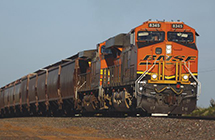 |
 |
|
| eNews • February 2017 | ||
| Promoting a Cost-Effective, Reliable and Competitive Transportation System |
||
 US rails under pressure to rejuvenate intermodalUS rails under pressure to rejuvenate intermodal
US rails under pressure to rejuvenate intermodalUS rails under pressure to rejuvenate intermodal
Suffering from declining coal, oil, paper, and forest product loads, US Class I railroads must juice up their intermodal services by moving good and products faster and more efficiently.
“The lowest cost supply chain will win,” David Garin, group vice president of industrial products at BNSF Railway, told the National Industrial Transportation League Transportation Summit in San Diego.
Commodity shippers are building bigger transloading facilities to reduce their unit shipping costs, but railroads likewise experience lower per-unit carrying costs from those bigger facilities, said Brad Hildebrand, global rail and barge lead at Cargill. Agricultural shippers are building facilities that can handle unit trains of 110 to 115 rail cars, and maybe up to 120 cars, he said.
For railroads seeking to squeeze greater use of their assets and provide sufficient capacity to customers, especially during periods of peak demand, the answer is to run faster, bigger trains, Garin said.
Railroads and rail shippers agree that better forecasting of a customer’s transportation needs and more sharing of data by both parties results in the railroads and their customers taking cost out of their operations. Railroads can better plan the size of their trains if customers give them advance information on the size of their shipments and the intended destinations, according to Jean-Jacques Ruest, executive vice president and chief management officer at Canadian National Railway. The railroad will operate more efficiently for itself and its customers if it knows what each train will look like before it leaves the terminal, he said.
Improving efficiency and taking cost out of the supply chain will be important ingredients to railroads’ success as they compete for domestic cargo with a trucking industry that is moving into driverless trucks and Uber-type operations, Ruest said. “It’s all about competition. If highway transport makes a breakthrough, the railroad has to respond,” he said.
Although North American intermodal volume began to rally in the later months of 2016, total volume for 2016 was still down 1.6 percent year-over-year, according to the Association of American Railroads. Domestic container volume growth, in particular, slowed, going from 6.4 percent year-over-year in the first quarter of 2016 to 3.3 percent in the third, according to the Intermodal Association of North America.
Although the Class I rail industry at large has said that there has been some success in converting domestic shipments from highway to rail in the past year, the trucking sector has made undeniable inroads grabbing market share, owing in large part to competitive pricing.
An index tracking truckload pricing has fallen more sharply in 2016 than one tracking all-in intermodal pricing, illustrating how motor carriers have generally been able to best their rail-riding counterparts on price.
The Cass Truckload Linehaul Index, which measures fluctuations in truckload pricing, declined 0.9 percent year-over-year in December, marking 10 consecutive months of year-over-year declines. Meanwhile, the Cass Intermodal Price Index, which measures changes in total intermodal per-mile costs, increased 1.5 percent year-over-year in December after rising 0.3 percent and 0.4 percent in November and October, respectively. Small gains, to be sure, but the first time the index has increased in nearly two years.
Those competitive trucking prices have translated into clear gains in the highway market sector, according to IANA. Highway volume in the third quarter of 2016 was up 14.6 percent from 2015, the group reported.
Railroads must also focus greater resources on freight sectors that are growing so they can offset rapidly declining shipments of energy products. Coal, once a mainstay of rail profits, offers a bleak future. Each of the major North American railroads reported significant coal volume declines in 2016, with most in the double-digits.
David Nahass, president of Railroad Financial Corporation, said the market fundamentals have already changed as domestic utilities shift from coal to natural gas. “The coal industry is looking to exports, but even that is problematic,” Nahass said.
Garin emphasized the trouble with coal, noting that no new coal-fired facilities have been built in 10 years, and looking to the future, “it’s not going to happen,” he said. Similar declines in shipments of paper and forest products and oil by rail have already happened or are happening. Even though there is still a good amount of oil drilling underway in North America, the tide seems to have turned in favor of pipelines, the speakers said.
For railroads, the confluence of these events means they must concentrate on moving other cargoes more efficiently, such as agricultural products and domestic intermodal merchandise. Hildebrand said Cargill will continue to ship by rail as long as service is consistent and reliable. On-time performance to export ports is crucial in the increasingly competitive agricultural sector, where US producers vie with those in South America and the Ukraine for the same overseas markets. Soybean shipments are increasing rapidly due to China’s “insatiable appetite” for the product, he said.
While Hildebrand conceded that demand for agricultural commodities can change rapidly and unexpectedly, and shippers expect railroads to be nimble enough to respond to changing demand, it’s not a one-sided obligation. “As a shipper, we have to plan better too,” he said.
The answer for shippers and railroads may be big data. Hildebrand noted that railroads have access to large amounts of data on their side, and shippers on theirs, so “we can both improve and drive efficiency on the information we already have,” he said.
Source: JOC.com
Soy Transportation Coalition |
|
